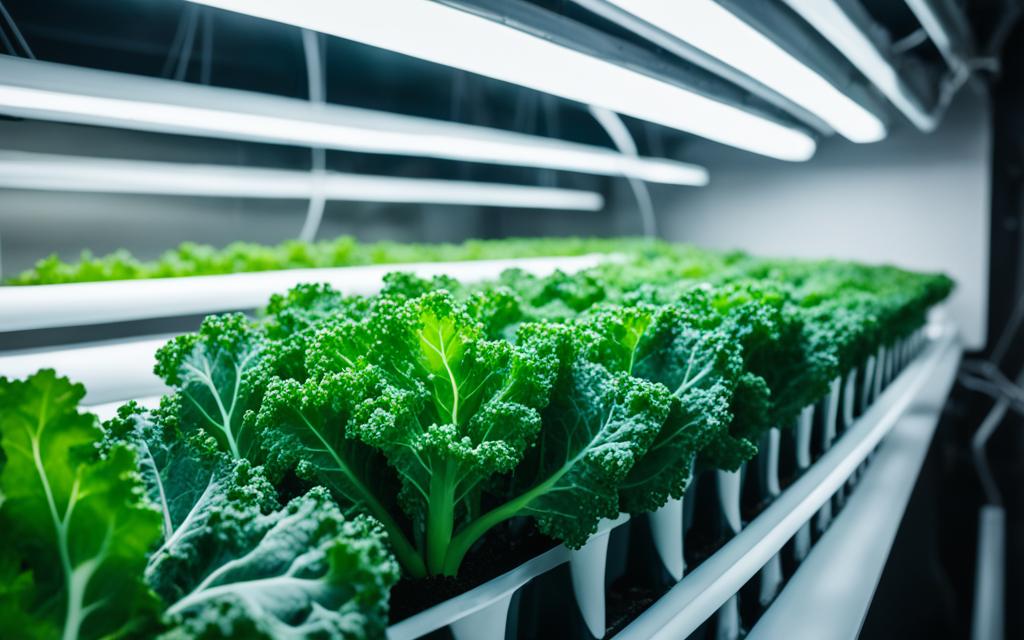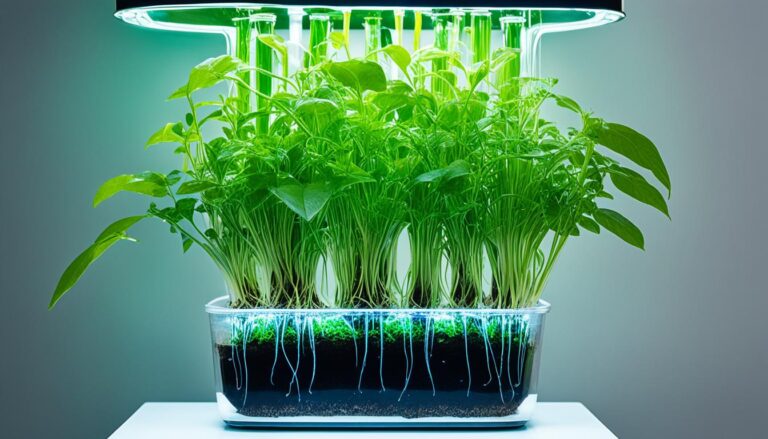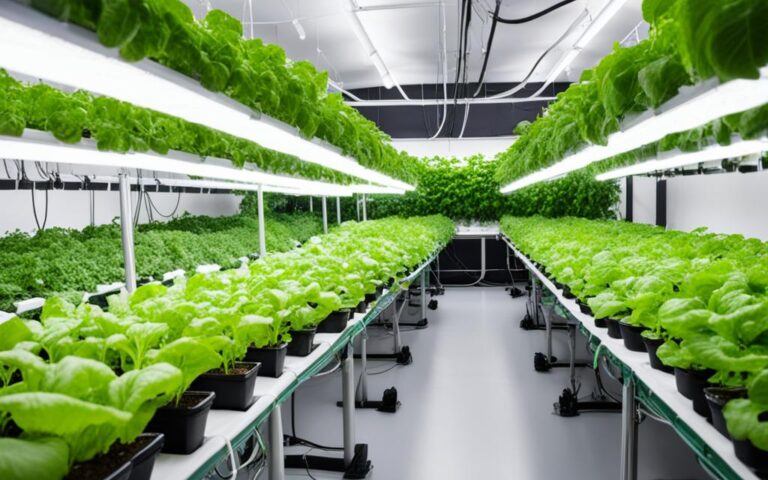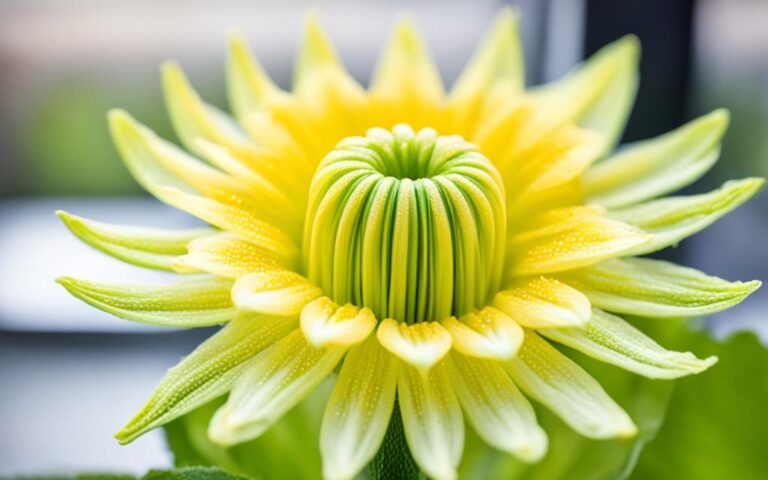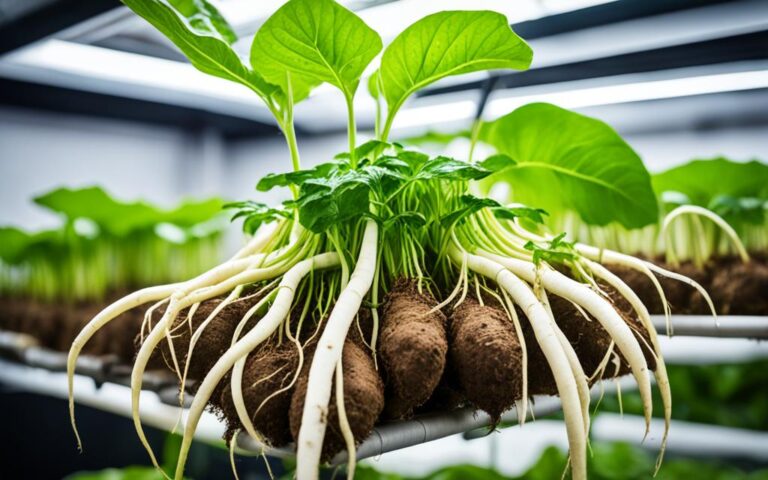Grow Fresh Hydroponic Kale at Home Effortlessly
Did you know that one cup of raw kale has over 600% of the daily vitamin K you need? This superfood is full of vitamins, minerals, and antioxidants. You can grow it at home with a hydroponic system and enjoy it all year.
Hydroponic kale grows faster, takes up less space, and is easier to maintain than traditional gardens. This guide will show you how to create and care for a hydroponic kale garden. You’ll get fresh, chemical-free kale easily.
Key Takeaways
- Hydroponic kale lets you grow this superfood all year, no matter the weather.
- It grows faster, needs less space, and is easier to care for than traditional gardens.
- Kale is full of vitamins, minerals, and antioxidants, making it great for your health.
- Grow your own fresh, chemical-free kale with hydroponics at home.
- It’s a sustainable, efficient way to grow leafy greens in cities and indoors.
Table of Contents
Introduction to Hydroponic Kale Cultivation
Hydroponic gardening is a new way to grow plants without soil. It’s changed how we grow our favorite greens, like hydroponic kale. This method uses a special system to give plants a nutrient-rich water solution. This lets them grow well and reach their full potential.
Hydroponic gardening is different from traditional gardening. It creates a perfect environment for kale to grow. By giving plants exactly what they need, like nutrients, water, and oxygen, hydroponics can make kale grow faster, produce more, and be more nutritious.
At the core of hydroponics is soilless cultivation. Instead of soil, hydroponics use things like expanded clay or rock wool to support the roots. This method cuts down on soil use and prevents pests and diseases, making growing cleaner and safer.
Indoor farming and using nutrient-rich water have many benefits. That’s why hydroponic kale is getting popular with gardeners and farmers. With this technology, you can have fresh, tasty, and healthy kale all year, right at home or in the city.
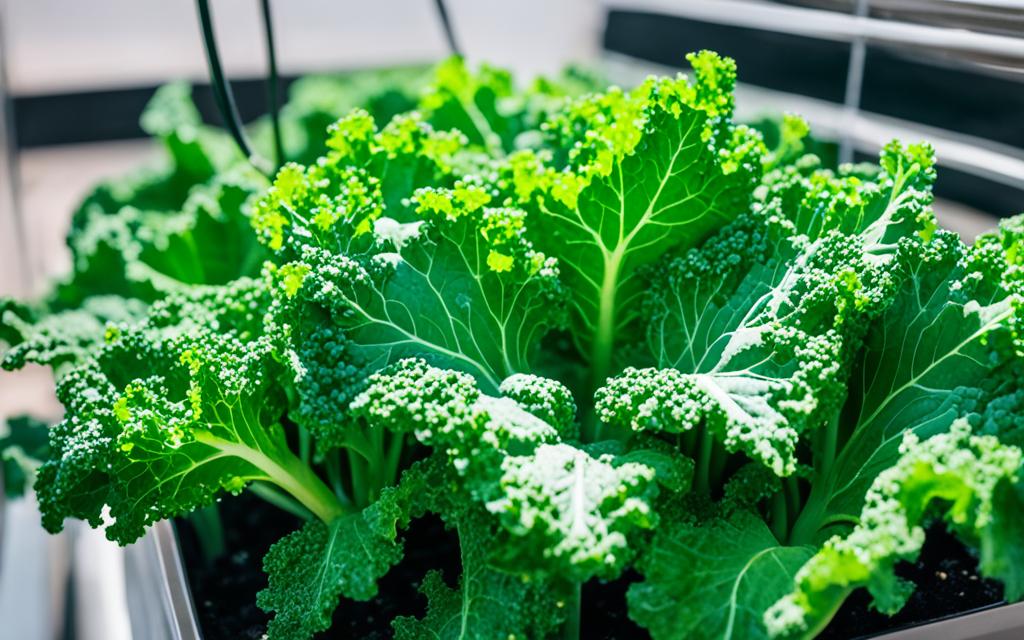
“Hydroponic gardening opens up a world of possibilities for growing our favorite greens, including the highly nutritious kale, in a controlled and efficient manner.”
Benefits of Growing Kale Hydroponically
Growing kale hydroponically has many advantages over traditional soil methods. This method lets home growers enjoy hydroponic kale benefits. These include more produce, better nutrients, and tastier kale.
Increased Yield and Year-Round Availability
Hydroponic systems are perfect for kale, leading to more higher yield hydroponic kale. You get a steady supply all year. Unlike soil farming, hydroponics doesn’t let weather stop you from growing.
Improved Nutrient Density and Flavor
Hydroponics lets you control nutrients and growing conditions. This makes nutritious hydroponic kale taste better. Without soil dirt and with the right vitamins and minerals, the kale is tasty and nutritious.
Reduced Pesticide and Contaminant Exposure
Pesticide-free hydroponic kale means less risk of harmful chemicals. Hydroponics uses less pesticides, making it a clean way to grow. This means a healthier, better harvest for you.
“Hydroponic kale cultivation allows me to enjoy fresh, nutrient-dense greens year-round, without the worry of pesticide residues or seasonal fluctuations in availability.”
Nutritional Value of Hydroponic Kale
Kale is known as a superfood because it’s packed with nutrients. Hydroponic kale is just as nutritious. It’s full of vitamins, minerals, and antioxidants. This makes it a great choice for a healthy diet.
Hydroponic kale is a top source of vitamins A, C, and K. It also has calcium, iron, and potassium. Plus, it has fiber, omega-3 fatty acids, and other good stuff. These nutrients help keep your immune system strong, support bone health, and lower the risk of chronic diseases.
- High in vitamins A, C, and K
- Rich in essential minerals like calcium, iron, and potassium
- Great source of fiber, antioxidants, and omega-3 fatty acids
- Can boost immune function, support bone health, and lower disease risk
“Hydroponic kale is a true nutritional powerhouse, packed with the essential nutrients our bodies need to thrive.”
Adding hydroponic kale to your meals brings many health benefits. It’s a superfood that supports your well-being.
Choosing the Right Hydroponic System
Choosing the right system for kale hydroponics is key. The Deep Water Culture (DWC) and Nutrient Film Technique (NFT) systems are top choices. In DWC, kale plants sit in net pots over a nutrient-rich water solution. The NFT system uses a thin film of nutrients in channels for the roots to absorb.
Both systems have their pros and cons. They need different setups for the best kale growth.
Think about these points when picking a hydroponic setup for kale:
- Space availability: DWC takes up more vertical space, while NFT fits well in small areas.
- Water usage: DWC uses more water, but NFT is more water-efficient.
- Nutrient delivery: DWC keeps nutrients steady, but NFT needs more attention.
- Maintenance: DWC is easier to keep up, but NFT might need more cleaning.
Choosing the right hydroponic systems for kale is crucial for success. It’s about creating the perfect environment for the plants. By picking the best system, growers can get the most out of this superfood.
“The beauty of hydroponics is that it allows you to grow high-quality produce year-round, regardless of the weather or season.”
Selecting Kale Varieties for Hydroponics
Choosing the right kale variety for hydroponics is key to a great harvest. Siberian Kale and Red Russian Kale are top picks for hydroponic gardens.
Siberian Kale
Siberian Kale is tough and does well indoors. It has big, rough leaves and a crunchy texture. This hydroponic kale cultivar grows well all year, giving you lots of healthy leaves.
Red Russian Kale
Red Russian Kale is softer and tastes sweeter. Its leaves are flat and tender. It’s a favorite for those who like a milder kale flavor.
Think about what you want from your kale varieties for hydroponics. Both Siberian Kale and Red Russian Kale are great for hydroponics. They offer a steady supply of tasty leaves for your cooking.
Starting Hydroponic Kale from Seeds
Growing hydroponic kale from seeds is rewarding and easy for home gardeners. The kale seed germination process is key to a successful hydroponic kale crop. It requires little effort.
Seed Germination Process
First, fill a container with a seed-starting medium made for hydroponics. Moisten the medium lightly and place kale seeds on it, spreading them out. Cover the seeds with a thin layer of the medium, about 1/4 inch deep.
Keep the container warm and humid, with temperatures between 70°F and 85°F. Mist the medium regularly to keep it moist but don’t soak it. Watch for kale seed germination and in 7-14 days, seedlings will appear.
When the kale seedlings have their first true leaves, they’re ready for your hydroponic system. Carefully move them to your setup, making sure to keep the roots safe.
By using these hydroponic seed starting tips, you can move from kale seeds to thriving hydroponic kale plants easily. This sets you up for a great harvest in your garden.
Transplanting Kale Seedlings to the Hydroponic System
Moving kale seedlings to a hydroponic system is key for their growth. It means taking the young plants from their starting container to the hydroponic setup. It’s important to handle and adjust the transplanting kale seedlings well to prevent shock and make a smooth integration into the hydroponic system.
When the kale seedlings have strong roots and are ready, it’s time for the move. Here’s how to make the hydroponic kale transplanting successful:
- Gently remove the seedlings from their container, keeping the roots safe.
- Make sure the hydroponic system is ready by preparing the growing medium or channels.
- Put the seedlings in their spots in the hydroponic system, making sure the roots touch the medium.
- Give the seedlings enough water and nutrients, and watch them closely for a few days to see how they adjust.
By following these steps for transplanting kale seedlings into a hydroponic system, you help them grow well and get ready for a big harvest.
“Proper transplanting techniques are crucial for the success of hydroponic kale cultivation. Taking the time to carefully integrate the seedlings into the system will pay off with a healthy, robust crop.”
Nutrient Management for hydroponic Kale
Getting the right balance of nutrients is key for hydroponic kale to grow well. Kale is packed with nutrients and needs a special approach to get what it needs in a hydroponic setup.
Essential Nutrients for Kale
Hydroponic kale needs a mix of important nutrients like nitrogen, phosphorus, and potassium. It also needs smaller amounts of iron, zinc, and magnesium. These nutrients help with photosynthesis, root growth, and keeping the plant healthy.
Monitoring and Adjusting pH and EC
Keeping an eye on the pH and EC of the nutrient solution is important. The ideal pH for hydroponic kale is between 5.5 and 6.5. The best EC level changes with the plant’s growth stage and type. By watching and adjusting these levels, growers can keep the perfect conditions for kale.
| Nutrient | Role in Kale Growth | Optimal Range |
|---|---|---|
| Nitrogen (N) | Promotes leaf growth and development | 150-200 ppm |
| Phosphorus (P) | Supports root growth and energy production | 30-60 ppm |
| Potassium (K) | Enhances disease resistance and stress tolerance | 150-250 ppm |
| Iron (Fe) | Crucial for chlorophyll production and photosynthesis | 2-4 ppm |
By keeping a close eye on pH and EC, growers can make sure their kale gets the best nutrients. This helps the plants do well in a hydroponic setup.
Light Requirements for Hydroponic Kale
Lighting is key for growing healthy hydroponic kale. Kale loves lots of light, especially blue and red wavelengths. These colors are vital for photosynthesis and growing strong leaves.
Kale needs 10-12 hours of light daily to grow well. In indoor setups, high-quality LED grow lights work great. They give the right intensity and spectrum for the plants.
For the best results, keep the light at the right distance from the plants. This distance depends on the grow light type. Usually, 12-24 inches is best to prevent damage.
The light cycle is also important. Kale does best with a regular light-dark cycle. You can control this in a hydroponic system. Trying different light schedules can help you find what works best for your kale.
With the right lighting, you’ll get a lot of tasty, healthy kale all year.
Temperature and Air Circulation for Optimal Growth
Keeping the right temperature and air flow is key for growing healthy hydroponic kale. Kale does best in a temperature of 60-70°F (15-21°C). This temperature helps with leaf growth and makes the kale taste better. Keeping your hydroponic system at this temperature range is vital for your kale to grow well.
Also, having enough air flow is important. Without enough air, you might get mold, disease, or poor nutrient uptake. Good air flow stops these problems and helps your kale get the oxygen it needs for strong roots and leaves.
To make the best environment for your hydroponic kale, try these tips:
- Use heating or cooling systems to keep the temperature between 60-70°F (15-21°C).
- Put in fans or vents to keep air moving in your hydroponic setup.
- Check the temperature and humidity often and adjust as needed to help your plants grow and stay healthy.
“Achieving the right balance of temperature and air circulation is essential for growing vibrant, flavorful hydroponic kale.”
By controlling the temperature and air flow in your hydroponic setup, you’ll give your kale the best conditions to grow. This leads to a lot of tasty kale all year.
Maintaining Water Quality and pH Balance
For a hydroponic kale garden to thrive, it’s key to keep the water quality and pH balance right. The ideal pH range for hydroponic kale cultivation is 5.5 to 6.5. This lets the plants get the nutrients they need. Using clean water and checking the pH often helps create the best environment for hydroponic kale.
Achieving Optimal Water Quality
To keep the water right for hydroponic kale, follow these steps:
- Use filtered or reverse osmosis water to remove impurities and minerals that could mess with the nutrient balance
- Check the pH and electrical conductivity (EC) often to make sure they’re just right
- Change the pH as needed with pH up or down solutions to keep it in the 5.5 to 6.5 range
- Watch the EC levels to make sure the nutrients match the kale’s growth stage
Importance of pH Management
pH management is key for your hydroponic kale to stay healthy and productive. The right pH balance lets plants take in important nutrients like nitrogen, phosphorus, and potassium. These nutrients are vital for strong growth and lots of nutrients.
| Parameter | Ideal Range | Importance |
|---|---|---|
| pH | 5.5 – 6.5 | Ensures nutrient availability and uptake |
| Electrical Conductivity (EC) | 1.5 – 2.5 mS/cm | Shows the amount of dissolved nutrients |
By keeping the water quality and pH balance in the best ranges, you give your hydroponic kale the perfect conditions. This leads to a big and healthy harvest full of nutrients.
Common Issues and Troubleshooting
Growing hydroponic kale seems easy, but even experts face challenges. Issues like nutrient deficiencies and pest and disease control need quick action. This keeps your hydroponic kale healthy and thriving.
Identifying and Addressing Nutrient Deficiencies
Nutrient imbalances can cause problems like discoloration and stunted growth in hydroponic kale. Keep an eye on your plants and fix problems fast. This ensures they get the nutrients they need for healthy growth.
- Watch for changes in leaf color, texture, and growth to spot nutrient issues.
- Change the nutrient solution as needed to fix any imbalances.
- Check the pH and electrical conductivity (EC) of the nutrient solution often. This keeps it right for kale.
Pest and Disease Management
Hydroponic systems can attract pests and diseases, harming your kale. It’s important to watch your plants closely and use organic pest control. This keeps your kale safe and healthy.
- Look for pests like aphids, spider mites, or whiteflies and act fast.
- Use natural predators like ladybugs or lacewings to fight pests safely.
- Keep your plants in the best conditions, like good air flow and the right humidity, to prevent diseases.
Being proactive helps solve hydroponic kale problems, nutrient deficiencies in hydroponic kale, and pest and disease control for hydroponic kale. This keeps your home-grown hydroponic kale healthy and productive.
Harvesting Your Hydroponic Kale Crop
Harvesting hydroponic kale is a big step in growing your own food. It usually takes 2-3 months from when you plant the seedlings. You can pick the big, mature leaves first, letting the plant keep growing. This way, you get fresh, healthy kale all season long.
Knowing when to harvest hydroponic kale is key. Pick the leaves when they’re dark green and big enough for you. They should be crisp and tender. Don’t pick leaves that are too old, as they might be tough and bitter.
For the best results, handle the leaves carefully when you pick them. Remove them gently to avoid hurting the plant’s core. Keep the kale fresh by storing it in the fridge. Use a damp paper towel or a sealed container to keep it fresh.
“Continuous harvesting of hydroponic kale ensures a steady supply of this nutrient-dense superfood throughout the year.”
By following these tips for harvesting hydroponic kale, you can grow a lot of this healthy green. This way, your family can enjoy it all year round.
Tips for Maximizing Hydroponic Kale Yield
To get the most out of a hydroponic kale garden, growers should use several techniques. Keeping the right temperature, light, and air flow is key. This helps the kale grow well in a hydroponic setup.
It’s also important to give the kale a balanced nutrient solution. Checking and adjusting the pH and EC levels of the solution is crucial. This makes sure the plants get what they need for healthy growth.
Quickly fixing any problems like nutrient shortages or pests can boost the kale yield. By doing this, growers can increase their harvest. They’ll have a steady supply of this nutritious and versatile leafy green.
